Intel’s 11th Gen Core Tiger Lake SoC Detailed: SuperFin, Willow Cove and Xe-LP
by Dr. Ian Cutress on August 13, 2020 9:01 AM EST- Posted in
- CPUs
- Intel
- SoCs
- Tiger Lake
- 10+
- Xe-LP
- Willow Cove
- Intel Arch Day 2020
- SuperFin
- 10SF
What is Xe-LP?
A big part of the Tiger Lake/Ice Lake comparison will be the performance difference in graphics. Where Ice Lake has 64 Execution Units of Gen11 graphics, Tiger Lake has 96 Execution Units but of the new Xe-LP architecture. On top of that, there’s the new SuperFin transistor stack that promises to drive frequencies (and power windows) a lot higher, making Tiger Lake more scalable than before.
Straight off the bat Intel’s graphs are showing that at the same voltage, where Ice Lake Gen11 achieves 1100 MHz, the new Xe-LP graphics will get to ~1650 MHz, a raw +50% increase. That means at Ice Lake’s peak power, we should expect Tiger Lake to perform at a minimum 2.25x better. Expanding beyond that, the peak for Tiger Lake seems to be in the 1800 MHz range, ultimately giving a minimum 2.45x more performance over Ice Lake. This is before we even start talking about the fundamental differences in the Xe-LP architecture compared to Gen11.
Intel is promoting Xe-LP as operating at 2x the performance of Gen11, so even though these numbers might easily suggest a 2.25x uplift before taking into account the architecture, it will ultimately depend on how the graphics is used.
Gen11 vs Xe-LP
For a more in-depth look into Intel’s Xe graphics portfolio, including HP, HPC, and the new gaming architecture HPG, Ryan has written an article covering Xe in greater detail. In this article, we’ll cover the basics.
In the Ice Lake Gen11 graphics system, each one of the 64 execution units consisted of two four-wide ALUs, one set of four for FP/INT, and the other set of four for FP/Extended Math. 16 of these execution units would form a sub-slide within Gen11.
For Xe-LP, that 4+4 per execution unit has been rebalanced for this target market. There are now 10 ALUs per execution unit, but in an 8+2 configuration. The 8 ALUs support 2xINT16 and INT32 data types, but also with new DP4a instructions can accelerate INT8 inference workloads. The new execution units also now work in pairs – two EUs will share a single thread control block to help assist with coordinated workload dispatch.
As with ICL, 16 of the EUs now form a sub-slice with the graphics, and slices are added in the SoC as performance is needed. What is new in Tiger Lake is that each sub-slice now has its own L1 data and texture cache, and the pixel backend runs 8 pixels/clock per two sub-slices.
Overall the graphics system can support 1536 FLOP/clock, with the samplers at 48 Tex/clock per sub-slice and a total of 24 pixel/clock in the back-end. LP in Tiger Lake has 16 MiB of its own L3 cache, separate from the rest of the L3 cache in the chip, and the interface to the memory fabric is doubled, supporting 2x64B/clock reads or writes or a combination of both.
Exact performance numbers for Xe-LP in Tiger Lake are going to be a question mark until we get closer to launch. Intel has stated that the discrete graphics version of LP, known as DG1, is due out later this year.
Xe-LP Media and Display
The other question on Tiger Lake on graphics will be the media and display support. Tiger Lake will be Intel’s first official support for the AV1 codec in decode mode, and Intel has also doubled its encode/decode throughput for other popular codecs. This means a full hardware-based 12-bit video pipeline for HDR and 8K60 playback support.
Display Support for Tiger Lake is also extended with four 4K display pipelines. Connections over DP1.4, HDMI 2.0, Thunderbolt 4, and USB4 Type-C simultaneously is how Intel expects users to operate if all four outputs are needed at once. The display engine also supports HDR10, 12-bit BT2020 color, Adaptive Sync, and support for monitors up to 360 Hz.
External Graphics and Hybrid Support
One of the interesting questions we posted to Intel during Architecture Day was surrounding how Xe-LP will operate in the presence of additional graphics, and potentially paired with a discrete version of LP later in the year. Unfortunately there seemed to be some confusion between the definitions of ‘hybrid’ graphics vs ‘switchable’ graphics, so we got that cleared up in time for the article.
At present, Intel expects almost all Tiger Lake solutions to run in devices where there is no discrete graphics solution – only the integrated graphics is provided as the primary compute for gaming and acceleration. However, Tiger Lake will support switchable graphics solutions with Xe-LP discrete graphics. Intel did not state if this was discrete graphics with respect to a built LP chip or an external discrete graphics solution through Thunderbolt.
Due to Tiger Lake’s PCIe 4.0 support and Thunderbolt 4 support, depending on how an exact Tiger Lake system is configured, Intel expects that any discrete graphics solution will operate at a lower latency, mostly due to the fact that the PCIe 4.0 lanes will be directly attached to the CPU, rather than a chipset. Intel quoted ~100 nanosecond lower latency. They also stated an 8 GB/s bandwidth to main memory, which seemed a bit low?
On the topic of hybrid graphics, where the integrated graphics and an Xe-LP discrete solution could work in tandem on the same rendering task, Intel stated that there is no plan to support a Multi-GPU solution of this configuration.


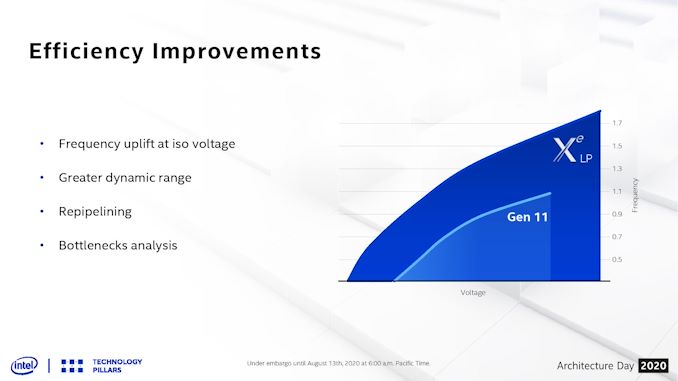
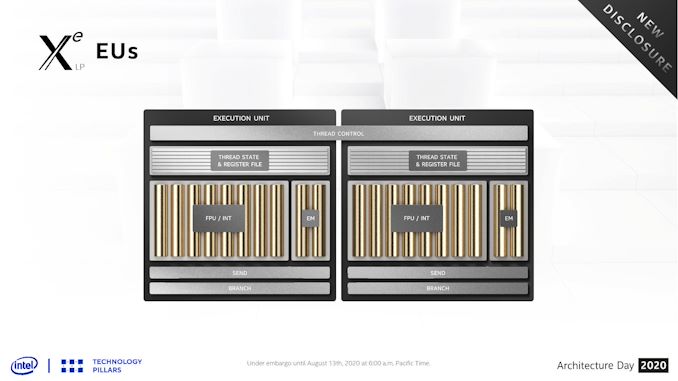
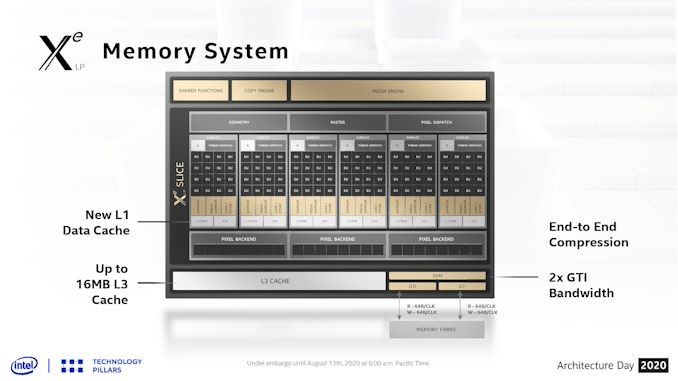
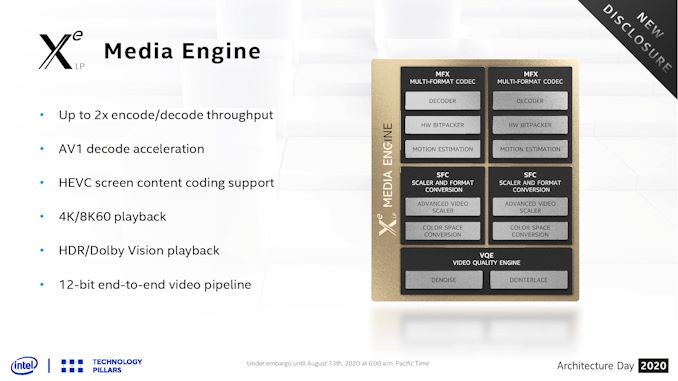
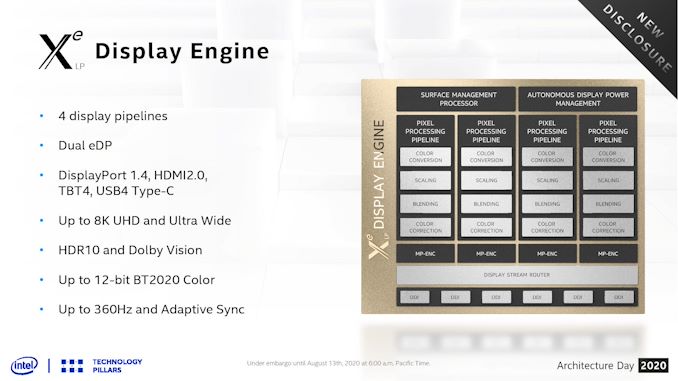








71 Comments
View All Comments
eastcoast_pete - Thursday, August 13, 2020 - link
Good news! Hope those announced products will actually ship this year, and not just in drip-drip-drip fashion. This will help keep Team Red on its toes, and that is good for all of us - as we learned during AMD's valley of tears, lack of competition means slower innovation and high prices.And, there is an actual chance those improvements are real; IMO, exhibit A for that is AMD has moved Cezanne's launch date earlier. Unless there is no real competition, why bother? They're barely able to ship enough Renoirs, so this suggests that AMD thinks these new Intel chips might be real, or real enough.
dullard - Thursday, August 13, 2020 - link
Which high prices are you talking about? Intel's top desktop processor, 2700K through 10700K all had about the same price, usually in the mid $300 range. The lack of AMD competition during the first half dozen years there didn't have almost any impact on price. When AMD was highly competitive at the 1 GHz race, prices were over $1000. There just isn't much impact on prices going from a monopoly to a duopoly.ZoZo - Thursday, August 13, 2020 - link
The high prices per core compared to how much cheaper those cores could have become with noteworthy competition. Also the high absolute prices of the many-core CPUs. Remember the HEDT platform CPU climbing up to $2000 and then the flagship 10th gen one (10980XE) introduced at half the price of the flagship 9th gen one (9980XE)? Sure AMD then went up to $4000 but the price per core is still much better than it was before Ryzen.Spunjji - Monday, August 17, 2020 - link
The high prices on that artificially-segmented category of "HEDT" for anyone who wanted more than 4 cores, perhaps? Or the fact that for those same prices you now get significantly more cores *and* more Ghz, which prior to the arrival of Ryzen was by no means guaranteed.You could also check the steadily-increasing prices of high-end laptops, where the lack of competition has been felt more keenly on both CPU and GPU fronts.
You're right that it doesn't drop things *that much* lower, but Intel have been delivering noticeable improvements in PP$ since AMD regained some semblance of competitiveness.
DannyH246 - Thursday, August 13, 2020 - link
WOW!!! More slides and paper talk from Intel!!! How exciting!shabby - Thursday, August 13, 2020 - link
Look at the bright side... it looks like they got a new person making those slides!Samus - Friday, August 14, 2020 - link
Hey, at least they are actually mass producing something on a new process!Jeff72 - Thursday, August 13, 2020 - link
So what would be the most efficient, lower core but highest clock rate CPU for desktop these days? I only would need maybe 4+ cores or so. I guess clock rate is more important to me but I also want low 10 nm process or lower for high efficiency. I'm only interested in air cooling also but want a quiet system overall. I feel so behind in my CPU knowledge these days. From what i've read, it seems AMD is doing very well these days. I'm currently running an Intel I7-4790K and have not felt the need to upgrade yet. Would like a huge bump in perceptible speed in general. I don't game much anymore but just want an overall fast and efficient and cool and quiet desktop replacement that could do gaming if I wanted to. What CPU is good now and what future CPU would be worth waiting for?fogifds - Thursday, August 13, 2020 - link
11th Gen Core for desktop looks really good. Rocket Lake architecture. Will be the last standard desktop CPU before Intel goes BIG.little core design like smartphones. Remains to be seen how Windows will deal with that.TouchdownTom9 - Thursday, August 13, 2020 - link
Not sure I really agree with you there. Rocket Lake looks to be a mediocre improvement over 10th gen. Still is going to be on 14nm (although they are backporting the micro arch from Ice/Tiger Lake). That is going to be challenged by AMD's Vermeer, which will be Zen 3 on a more advanced 7nm(EUV?) node with a unified cache, 8 core CCX, higher clocks, and a 15-20% IPC increase. That should hold the crown for the best chip lineup for your money when released in a few months. Gaming will be a close call (lets see the impact of an 8 core ccx), but unless Intel fundamentally changes their pricing scheme you will likely be able to get the 11th gen i7 for the same price as Ryzen 4900x (same for i5 vs R7). Not looking to be a fanboy for AMD (I'm impressed by what I've read about Tiger lake in this article), but AlderLake seems to be much more promising than Rocket Lake for Intel although yes it will be very interesting to see how the BIGlittle strategy is used by Windows. Just thought you might be overhyping Rocketlake and ignoring Vermeer.